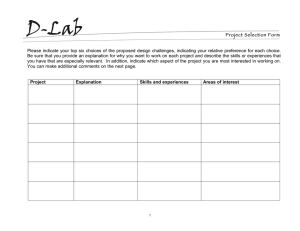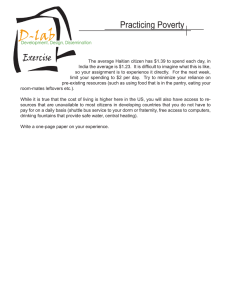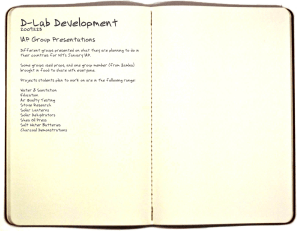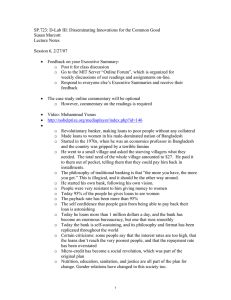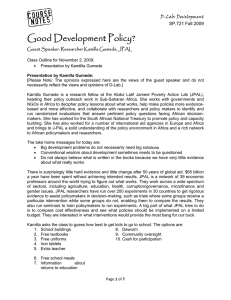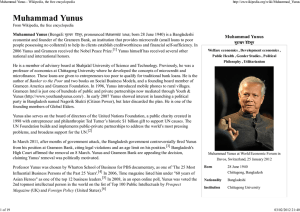D-Lab Development Good Development Policy (?) Started working in
advertisement
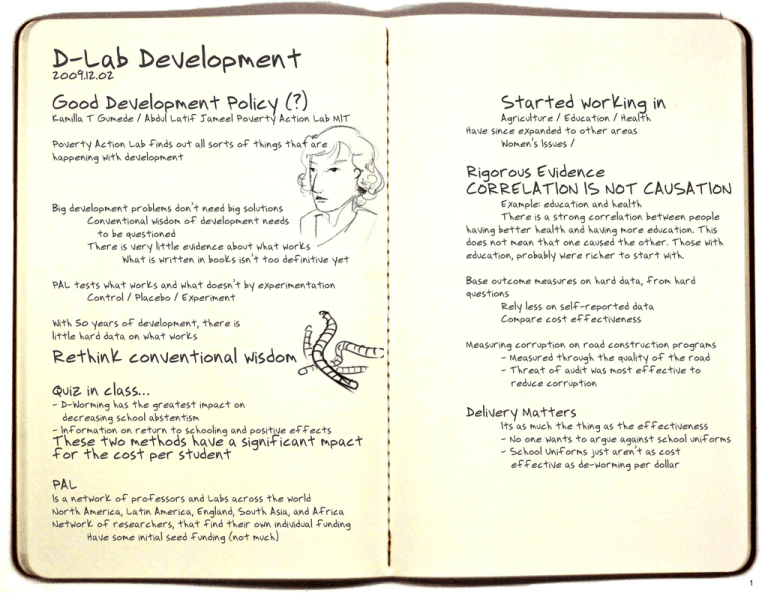
D-Lab Development 2009.12.02 Good Development Policy (?) Kamilla T Gumede / Abdul Latif Jameel Poverty Action Lab MIT Poverty Action Lab finds out all sorts of things that are happening with development Big development problems don’t need big solutions Conventional wisdom of development needs to be questioned There is very little evidence about what works What is written in books isn’t too definitive yet PAL tests what works and what doesn’t by experimentation Control / Placebo / Experiment With 50 years of development, there is little hard data on what works Rethink conventional wisdom Quiz in class… - D-Worming has the greatest impact on decreasing school abstentism - Information on return to schooling and positive effects These two methods have a significant mpact for the cost per student Started working in Agriculture / Education / Health Have since expanded to other areas Women’s Issues / Rigorous Evidence CORRELATION IS NOT CAUSATION Example: education and health There is a strong correlation between people having better health and having more education. This does not mean that one caused the other. Those with education, probably were richer to start with. Base outcome measures on hard data, from hard questions Rely less on self-reported data Compare cost effectiveness Measuring corruption on road construction programs - Measured through the quality of the road - Threat of audit was most effective to reduce corruption Delivery Matters Its as much the thing as the effectiveness - No one wants to argue against school uniforms - School Uniforms just aren’t as cost effective as de-worming per dollar PAL Is a network of professors and Labs across the world North America, Latin America, England, South Asia, and Africa Network of researchers, that find their own individual funding Have some initial seed funding (not much) 1 Best Buys (impact/dollar) De-Worming More and more places accepting it Incentives to immunize Vaccines are free, but still have low uptake Incentives (like a bag of lentils) can increase uptake WHY? Explained through procrastination Easier to wait now, and put off until tomorrow Same for people everywhere around the world (Eat the chocolate now, and run tomorrow) When you want someone to do something, its worth offering small incentives Example in Malawi Have youth be tested for HIV Offering 1 days salary (less than $1), doubled attendance rate Smart Incentives There is a lot of technology, that people aren’t accessing … Farmers in Kenya to use fertilizer Get them to buy it when they have money (after harvest) Voucher to buy fertilizer (at specific time) + free delivery This is a small subsidization in form of delivery, but effective in relation to subsidizing the cost at the beginning of planting season In the area of preventive health care, people are particularly bad at doing what is good for them. Shouldn’t give everything away for free, but some things are more effective when free More about Best Buys: Poveryactionlab.org/mdg PAL has a series of strategies for testing Social Initiatives in ways that aren’t the same as testing for medical Initiatives Yunus Challenge History of Yunus Challenge The first Yunus Challenge about TB drug use One Teams Solution (Angela explains) Take drug / pee on strip / text in result / redeem for cell phone minutes This to replace costly DOTS (direct observation treatment) This small incentive is more cost effective than DOTs Clean Hands (this years Yunus Challenge) Clean hands are an element of diarrhea prevention Free Bednets Does charging for them increase use? Study in Kenya Making bednet free increase the people who use them Emphasis on seeing who USED them When purchased, more often the man uses it When given away for free, women and children are more likely to use it And be willing to pay for it later when bed net 2 Final Take Aways / Behavioral Responses Procrastination (examples: immunization, fertilizers) Overcoming our lazziness Channel Factors (example: Tetanus, Lewin 1951) - If you want people to do something, you have to show them a path - A map to a clinic, partially filled out paperwork, 401k set to automatic enrollment -People (everywhere) like to be tricked into participation Effective Information Campaigns (example: small group discussions, loss aversion, keep it simple) Arsenic in wells, giving people information which wells were worst, dividing information confused people, and was too much for people to handle Something Special About Zero (example: bednest) Preventative healthcare is tough for people Summary: - Question conventional wisdom A lot to learn from small contexts Not all big problems require big solutions Cheap, practical solutions exist Behavioral responses matters Try reading these books: Influcence Nudge 3 MIT OpenCourseWare http://ocw.mit.edu EC.701J / 11.025J / 11.472J D-Lab I: Development Fall 2009 For information about citing these materials or our Terms of Use, visit: http://ocw.mit.edu/terms.
